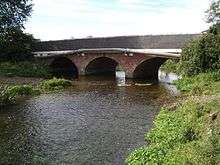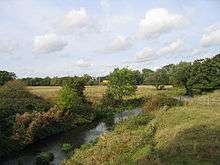River Blythe
| Blythe | |
|---|---|
 The river near Hampton-in-Arden | |
| Country | England |
| Basin | |
| Main source |
Earlswood Lakes, Warwickshire 52°21′58″N 1°50′00″W / 52.366184°N 1.833267°W |
| River mouth |
Confluence with the Tame at Ladywalk 52°28′0″N 1°40′45″W / 52.46667°N 1.67917°WCoordinates: 52°28′0″N 1°40′45″W / 52.46667°N 1.67917°W |
| Progression | Tame—Trent—Humber—North Sea |
The Blythe is a river in the English Midlands that runs from Warwickshire, through the borough of Solihull and on to Coleshill. It runs along the Meriden Gap in the Midlands Plateau, is fed by the River Cole and is a tributary of the Tame beside the West Midland Bird Club's Ladywalk reserve. This then joins the Trent, whose waters reach the North Sea via the Humber Estuary.

The river rises at various sources near Earlswood Lakes, but the principal tributary is listed as Spring Brook (52°21′03″N 1°50′37″W / 52.350915°N 1.843601°W; grid reference SP107725). From here it winds north east, skirting Cheswick Green, towards Solihull. Here it passes through a local wildlife park, Malvern and Brueton Park and Nature Reserve. From here it meanders east, past several old country houses—Old Berry Hall, Ravenshaw Hall and Eastcote Hall—before turning sharply south towards Barston, which is encircled within a large meander of the river. At Temple Balsall the Cuttle Brook feeds the river, which now arcs north, and again close by Barston. Past Hampton in Arden the river is fed by Shadow Brook, at Diddington Hall. Travelling further north it passes to the east of Coleshill, and is fed by the River Cole, only a few hundred yards before it itself feeds into the River Tame (52°31′20″N 1°41′18″W / 52.522317°N 1.688242°W; grid reference SP212916), at Ladywalk Nature Reserve.

The river is "a particularly fine example of a lowland river on clay" according to its Sites of Special Scientific Interest citation. The SSSI was notified in 1989, and includes a 24-mile (39 km) stretch of the river from near its source to the point it joins the River Tame.[1] The Blythe has a wide range of natural geographical features such as riffles, pools, small cliffs and meanders, combined with a high diversity of substrate types ranging from fine silt and clay in the lower reaches to sands and gravels in the upper and middle reaches. The structure of this river is very variable and diverse, and is important as a rare example of such in lowland Britain.[1]

The diverse physical features of the Blythe are matched by its diverse plant communities. Botanically, the Blythe is one of the richest rivers in lowland England, with the most species-rich sections containing as many species as the very richest chalk streams.[1] In addition, several damp, unimproved meadows occur along the length of the river; they receive some of their water from annual flooding and are largely dependent upon the river for the maintenance of a high water-table.[1] As well as the rich and diverse flora, the river supports a diverse invertebrate community with a wide range of molluscs, oligochaetes and caddisflies[1]
The river is popular with anglers along much of its length, although in dry weather it can become very shallow in places so deep holes should be sought. Species to be found include Perch, Chub and Dace with the occasional summer Carp being caught. The river also holds Tench, Bream and Rudd and more recently a small number of Barbel have been caught.
It is one of the cleanest rivers in England..
See also
References
External links
- River Blythe. Retrieved on 2008-05-24